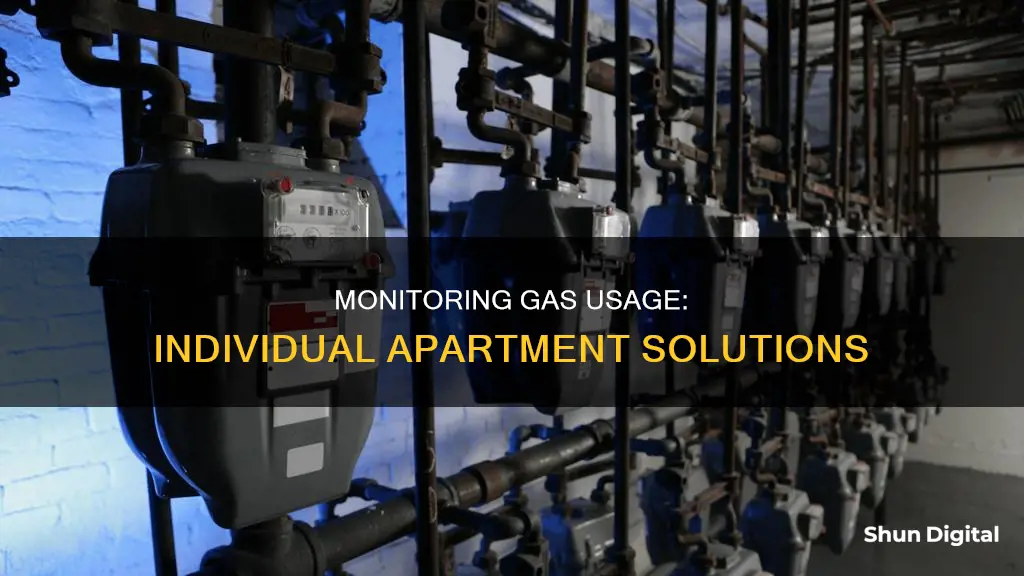
Monitoring individual gas usage in an apartment is important for budgeting and reducing one's carbon footprint. While there are no specific devices for tracking gas usage, one can monitor it by taking readings from their gas meter, which is usually located near the front door or around the side of the house for houses, and in a central location such as the basement or car park for apartments. Additionally, one can examine their utility bills for charges related to natural gas or propane. For a more accurate and hassle-free way of monitoring gas usage, one can also opt for a smart meter, which shows real-time energy usage and can help manage energy use more efficiently.
| Characteristics | Values |
|---|---|
| How to identify if your apartment uses gas | Check your utility bills for charges related to natural gas or propane |
| Ask your landlord or property management company about the utilities included in your rent | |
| Examine your appliances – gas stoves, ovens, and dryers typically have a pilot light or igniter, while electric appliances usually have a coiled heating element or smooth glass surface | |
| Look for a gas meter, typically located on the outside of the building or in a central location for apartments | |
| How to monitor gas usage | Install a smart meter to track real-time gas usage and identify appliances with high energy consumption |
| Review your gas bill each month to ensure accuracy and catch any errors | |
| Contact your gas company or utility provider to inquire about gas usage data or access online account information | |
| Conduct regular inspections and maintenance of gas appliances to ensure safety and efficiency |
What You'll Learn

Understand your gas meter
To understand your gas meter, it's important to know that natural gas is commonly measured by the cubic foot, and you are billed by the thousands of cubic feet (MCF) or hundreds of cubic feet (CCF). You may also be billed by the therm, which is approximately the same as a CCF or 100 cubic feet.
A gas meter is driven by the force of the moving gas in the pipe, and the speed of the flow. Each time the dial with the lower value makes one complete revolution, the pointer on the next higher-value dial moves ahead by one digit.
When reading a gas meter, note that the dials have arrows pointing in the direction the needle spins. The number above the dial indicates how much the value increases per revolution of the needle. For example, if the needle on the rightmost dial spins from 0 and back to 0, you've used 1,000 cubic feet of gas.
When reading the meter, read and write down the numbers as shown on the dials from left to right. If the pointer is directly on a number, use that number. If the pointer is between two numbers, use the smaller number. The exception is when the pointer is between 9 and 0; in this case, 9 is the smaller number.
If you're unsure whether your apartment has a gas meter, you can look for a metal box on the wall with a glass window, typically located on the outside of the building. You can also ask your landlord or gas company for assistance.
By understanding your gas meter and monitoring your usage, you can make informed decisions to reduce your gas consumption and lower your utility bills.
Monitoring CPU Usage: JMeter's Performance Insights
You may want to see also

Monitor daily usage
Monitoring your daily gas usage can provide valuable insights into your consumption patterns and help you identify areas where you can reduce your gas bills and carbon footprint. Here are some effective ways to monitor your gas usage on a daily basis:
Meter Readings
Take regular readings from your gas meter to track your daily usage. Gas meters are typically located near the front door or around the side of a house. If you live in an apartment, the meters for each unit are usually in a central location, such as the basement or car park, and are labelled with unit numbers. By recording the readings at the same time every day, you can calculate your daily gas consumption and identify any unusual spikes or patterns.
Smart Meters
Consider installing a smart meter, which will show you exactly how much gas you're using in real time. Smart meters are devices that attach to your gas meter and provide accurate, real-time information on your gas usage. They can help you identify which appliances are using the most gas and allow you to monitor your usage patterns. Additionally, smart meters eliminate the need for manual meter readings and estimated bills, as they send usage data directly to your supplier.
Bill Analysis
Examine your utility bills closely to understand your gas usage. Your gas charges will typically be listed separately from other utilities like electricity or water. Compare your monthly and annual gas consumption by reviewing your latest energy bills. Look for trends or unusual spikes in usage, and calculate the average daily usage based on the provided data. This will help you set benchmarks and identify areas for improvement.
Appliance Inspection
Pay attention to the appliances in your apartment that typically use gas, such as stoves, ovens, and water heaters. Check for any signs of malfunction or damage, and ensure proper maintenance and safety checks are conducted regularly. By being mindful of the condition and usage of these appliances, you can make more informed decisions about your gas consumption.
Contact Landlord or Property Manager
If you're unsure about your gas usage or need assistance in locating your gas meter, don't hesitate to contact your landlord or property manager. They can provide valuable information about the utilities included in your rent and offer guidance on monitoring your gas consumption. They may also have access to centralised data or historical records that can help you understand your daily gas usage patterns.
Monitoring Energy Usage: Circuit Box Insights
You may want to see also

Compare gas providers
When comparing gas providers, there are several factors to consider to ensure you get the best deal for your needs. Here are some key areas to focus on:
- Pricing Structures: Gas prices can vary between suppliers due to differences in tariffs and fees. Some companies may offer lower rates per unit of gas consumed but charge higher service or supply charges. Compare each provider's pricing structure carefully and calculate your estimated monthly costs based on your average consumption levels.
- Usage Rates: This refers to the cost you'll pay for using gas in your home, usually represented as cents per megajoule (c/MJ). Understanding usage rates is crucial in determining the overall cost of your gas bill.
- Supply Rates: Supply rates refer to the charge per day for being connected to the gas mains. Even if your gas usage is minimal, supply charges are generally a fixed portion of your bill that you'll be billed for regardless.
- Contract Length and Terms: Different providers offer varying contract lengths, from month-to-month agreements to long-term contracts spanning multiple years. Longer contracts may offer price stability but often come with exit fees if you decide to switch providers before the term ends.
- Discounts and Incentives: Many gas providers offer discounts or incentives to their customers. For example, you may receive a percentage discount on your bill for signing up for direct debit payments or paperless billing.
- Green Energy Options: If environmental sustainability is important to you, look for providers that offer carbon offset programs or renewable natural gas (biogas) options to reduce greenhouse gas emissions.
- Payment Options and Billing Frequency: Different gas providers may offer various payment methods such as direct debit or credit card payments, and billing frequencies, such as monthly, quarterly, or bi-annually. Consider your preferred payment method and billing frequency for better budget management.
- Customer Service Quality: Efficient and responsive customer service is crucial when dealing with utility providers. Compare providers based on their customer support channels, response times, and operating hours to ensure your queries are promptly addressed.
By carefully evaluating these factors and calculating potential savings, you can make an informed decision when comparing gas providers and choose the one that best suits your budget and preferences.
Monitoring Bandwidth Usage: PRTG's Per-IP Address Insights
You may want to see also

Understand billing types
Understanding the different billing types is an important step in monitoring individual apartment gas usage. Here is a detailed guide to help you navigate the different billing types:
Understanding Billing Types:
- Estimated billing: This type of billing occurs when your gas supplier does not receive your meter readings. As a result, they estimate your gas usage based on factors such as previous consumption patterns and the time of year. While this method is convenient, it may not always be accurate, leading to fluctuations in your monthly bills.
- Accurate billing: This type of billing is based on recent meter readings, either from a professional meter reader or readings that you provide to your supplier. Accurate billing ensures that you are charged for your actual gas usage, providing a more reliable basis for monitoring your gas consumption.
- Smart metering: Smart meters are devices that record your gas consumption in real time and transmit this information directly to your supplier. They eliminate the need for manual meter readings and provide accurate, up-to-date data on your gas usage. Smart meters are usually installed at no upfront cost to the customer and offer benefits such as real-time information on energy use and the ability to choose better energy plans.
- Traditional metering: Traditional meters, also known as analogue meters, are typically mechanical devices that measure gas usage by tracking the volume of gas passing through the meter. They require manual readings, which can be time-consuming and prone to human error. Traditional meters do not provide real-time data, making it challenging to detect issues like leaks promptly.
- Submetering: Submetering is relevant when multiple tenants or apartments share a gas supply. It involves installing individual meters for each tenant or apartment, allowing for more precise billing and usage monitoring. This approach ensures that tenants pay for their actual gas consumption, promoting fairness and reducing disputes over utility bills.
- Fixed-rate billing: With this billing type, you pay a set amount for your gas usage, regardless of how much gas you actually consume. This can be beneficial if you want predictable monthly bills, but it may not provide incentives for conserving gas usage.
- Variable-rate billing: Variable-rate billing means that the price you pay for gas can change over time, depending on market conditions and other factors. This type of billing can lead to fluctuations in your monthly bills but may offer opportunities for savings during periods of low gas prices.
Understanding these billing types will empower you to make informed decisions about your gas usage and choose the most suitable billing option for your individual apartment. Remember to review your bills regularly, as this can help you identify any discrepancies or unusual usage patterns, ensuring that you are charged accurately for your gas consumption.
Monitoring Data Usage: Track Device Consumption
You may want to see also

Get a smart meter
Smart meters are an excellent way to monitor individual gas usage in an apartment. They are digital devices that connect remotely with your utility company and provide accurate, real-time data on your energy consumption. Here are some reasons why getting a smart meter is a great idea:
Accurate and Real-Time Data
Smart meters measure and record your gas usage, just like conventional meters. However, smart meters provide real-time data, allowing you to monitor your usage patterns and make informed decisions to reduce your bills and carbon footprint.
No More Estimated Bills
With smart meters, you can eliminate estimated bills. The meters send your usage data directly to your utility provider through a secure wireless connection, ensuring that your bills are based on actual readings rather than estimates.
Improved Bill Accuracy
Smart meters improve bill accuracy by providing precise data on your energy consumption. This helps you understand your usage patterns and make better decisions to reduce costs.
Enhanced Control Over Energy Usage
Smart meters allow you to track your energy usage and make adjustments as needed. You can identify which appliances are consuming the most energy and make changes to reduce your overall consumption and spending.
Remote Access and Alerts
Smart meters often come with an in-home display that shows your energy usage data. Additionally, some providers offer online portals or apps that allow you to access your energy data remotely. You can also set up alerts to notify you when your usage moves into a higher-cost tier, helping you manage your budget effectively.
Better Management of Outages
Smart meters can quickly identify and report power failures, enabling your utility company to act swiftly and restore service more efficiently.
Easy Installation
The installation process for smart meters is straightforward and typically takes less than 15 minutes. In most cases, you won't even need to be at home during the installation.
No Additional Charges
Smart meter installation is usually offered at no direct charge. The cost of the project is often funded by the utility company and included in your rates.
Improved Safety
Smart meters enhance safety by promptly alerting your utility provider in case of a power outage in your area. This enables them to dispatch repair teams and restore electricity quickly.
Environmental Benefits
By monitoring your energy usage with a smart meter, you can make conscious decisions to reduce your consumption and lower your carbon footprint. This not only saves you money but also contributes to a greener and more sustainable future.
Monitoring Heating Oil Usage: Efficient Methods for Homeowners
You may want to see also
Frequently asked questions
Check your utility bills for charges related to natural gas or propane. If you're unsure, ask your landlord or property management company.
Gas meters in apartments are typically located in central areas such as basements or car parks and labelled with unit numbers. They may also be found near the front door or outside the building in a service riser, ceiling, garbage room, or plant room.
There are two types of gas meters in Australia: metric and imperial. Metric meters use cubic meters (m3), while imperial meters use cubic feet (ft3). Read all digits from left to right, including leading zeros.
Gas meters are typically read every three months by authorised meter readers, who calculate your bill based on gas pressure usage.
If you smell gas, leave your apartment immediately and call your gas company or emergency services. Do not use any electrical devices, turn on/off switches, or create any sparks (e.g., lighting matches or candles).







